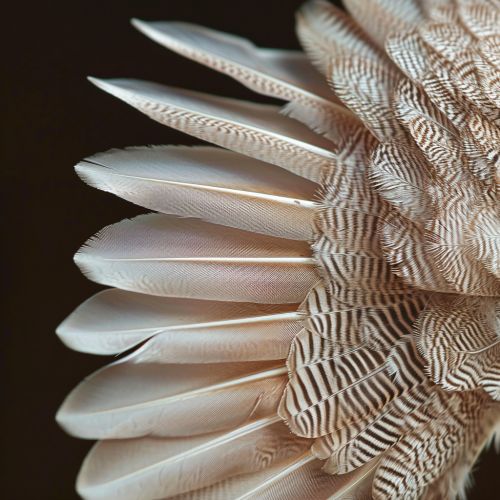Wings
Introduction
Wings are a type of appendage that are typically used for flight in various species of animals, particularly birds, bats, and insects read more. They can also be found in certain species of fish and reptiles, although these are generally used for gliding or leaping rather than sustained flight. Wings are a prime example of convergent evolution, where different species independently evolve similar traits as a result of having to adapt to similar environments or ecological niches learn more.


Anatomy
The anatomy of wings can vary greatly among species, but there are some common features. Most notably, wings are characterized by a strong, lightweight framework of bone or chitin covered in scales, feathers, or skin. This framework is often highly adapted for flight, with a streamlined shape and a high aspect ratio (the ratio of wing length to wing width) to minimize drag read more.
Bird Wings
Bird wings are composed of a strong but lightweight framework of bones, which are hollow and filled with air for even greater lightness. The primary flight feathers are attached to the "hand" part of the wing, and the secondary flight feathers are attached to the "arm" part. These feathers are highly specialized for flight, with a stiff central shaft and interlocking barbs to create a smooth, flat surface. The feathers are arranged in a specific pattern, with the primary flight feathers being the longest, and each subsequent feather being slightly shorter than the one before it.
Bat Wings
Bat wings are a unique adaptation among mammals. They are formed by a thin membrane of skin stretched between the elongated fingers of the bat. This membrane, called the patagium, is extremely flexible and allows the bat to maneuver in flight with great precision. The bones of the bat wing are much thinner than those in other mammals, reducing weight and making flight easier.
Insect Wings
Insect wings are formed from a double layer of the insect's exoskeleton, which is stiffened by a network of veins. These veins also carry hemolymph (the insect equivalent of blood) and help to cool the insect during flight. Insect wings are often highly patterned, with scales or pigments creating a wide variety of colors and patterns.
Evolution
The evolution of wings is a complex topic that is still not fully understood. It is believed that wings evolved independently in different groups of animals, in a process known as convergent evolution. There are several theories about how wings first evolved, but most agree that they likely developed from existing structures, rather than appearing de novo.
Birds
The evolution of bird wings is closely tied to the evolution of birds themselves. It is generally believed that birds evolved from theropod dinosaurs, and that the wings of birds are simply modified dinosaur arms. This theory is supported by the discovery of numerous theropod fossils with well-preserved feathers.
Bats
The evolution of bat wings is less well understood, due to a lack of fossil evidence. However, it is generally believed that bats evolved from small, arboreal mammals that used their webbed hands and feet to glide from tree to tree.
Insects
The evolution of insect wings is a topic of ongoing debate. Some scientists believe that insect wings evolved from gill-like structures on the bodies of aquatic insects, while others believe they evolved from rigid, spiny appendages used for locomotion or sensory perception.
Function
The primary function of wings is to enable flight. This is achieved through the generation of lift, which counteracts the force of gravity. The shape and structure of the wing are critical in determining its aerodynamic properties and thus its ability to generate lift.
Birds
In birds, the wing operates on the principle of the airfoil, a shape that generates lift when air flows over it. The bird wing is a highly efficient airfoil, with a curved upper surface and a flatter lower surface. This shape causes air to flow faster over the top of the wing than the bottom, creating a pressure differential that generates lift.
Bats
Bat wings operate on the same basic principle as bird wings, but with some key differences. Because the wing is a flexible membrane, the bat can change the shape of its wing in flight, allowing for more precise control. This makes bats highly maneuverable, capable of flying in tight spaces and even hovering in place.
Insects
Insect wings operate on a different principle than bird or bat wings. Instead of a single, rigid airfoil, the insect wing is a flexible, oscillating structure that generates lift through a complex interaction of forces. This allows insects to fly in a wide range of conditions, from calm air to turbulent winds.
